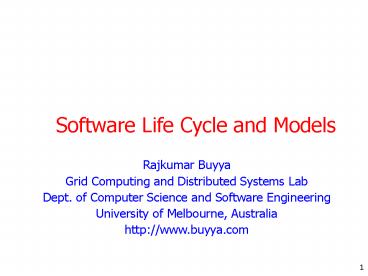Software Life Cycle and Models - PowerPoint PPT Presentation
Title:
Software Life Cycle and Models
Description:
Software life-cycle model defines how different phases of the life cycle ... Synchronize-and-stabilize model. Spiral model. Object-oriented life-cycle models ... – PowerPoint PPT presentation
Number of Views:248
Avg rating:3.0/5.0
Title: Software Life Cycle and Models
1
Software Life Cycle and Models
- Rajkumar Buyya
- Grid Computing and Distributed Systems Lab
- Dept. of Computer Science and Software
Engineering - University of Melbourne, Australia
- http//www.buyya.com
2
Software Process
- Software Process defines the way to produce
software. It includes - Software life-cycle model
- Tools to use
- Individuals building software
- Software life-cycle model defines how different
phases of the life cycle are managed.
3
Phases of Software Life-cycle
- Requirements
- Specification (Analysis)
- Design
- Implementation
- Integration
- Maintenance
- Retirement
4
Requirements
- Assumption
- The software being considered is considered
economically justifiable. - Concept exploration
- Determine what the client needs, not what the
client wants - Document - Requirements Document
5
Specification (Analysis) Phase
- From the customer requirements identify what to
build. - Specifications must not be
- Ambiguous
- Incomplete
- Contradictory
- Document Specification Document
6
Design Phase
- From the specification identify how to build.
- Design involves two steps
- Architectural Design Identify modules
- Detailed Design Design each modules
- Document Architecture Document, Design Document
7
Implementation Phase
- Implement the detailed design in code.
- Developer testing
- Unit testing
- Module testing
- Document Commented source code
8
Integration Phase
- Combine the modules and test the product as a
whole. - Testing includes
- Product testing
- Acceptance testing
- Document Test cases and test results
9
Maintenance Phase
- Any changes after the customer accepts the
system. - Maintenance phase is the most expensive
- Lack of documentation
- Regression testing
- Document Documented Changes, Regression test
cases
10
Retirement Phase
- Good software is maintained
- Sometimes software is rewritten from scratch
- Software is now un-maintainable because
- A drastic change in design has occurred
- The product must be implemented on a totally new
- hardware/operating system
- Documentation is missing or inaccurate
- Hardware is to be changedit may be cheaper to
rewrite - the software from scratch than to modify it
- True retirement is a rare event
11
Life-Cycle Models
- Build-and-fix model
- Waterfall model
- Rapid prototyping model
- Incremental model
- Extreme programming
- Synchronize-and-stabilize model
- Spiral model
- Object-oriented life-cycle models
- Comparison of life-cycle models
12
Build and Fix Model
13
Notes
- Most software is developed using build-and-fix
model. Basically there is no model. - No specifications
- No design
- This model is completely unsatisfactory and
should not be adopted. - Need life-cycle model
- Game plan
- Phases
- Milestones
14
Waterfall Model
15
Notes
- Output from one phase is fed as input to the next
phase. - One phase is completed, documented and signed-off
before the next phase begins. - Advantages
- Each phase is well documented.
- Maintenance easier.
- Disadvantages
- If there is a mismatch between what the client
wanted and was is built this will not be known
till the product is delivered.
16
Rapid Prototyping Model
17
Notes
- A prototype of the product is build rapidly and
shown to the client before the product is
completely built. - Advantages
- Any mismatches between requirement and the
product can be found early. - Disadvantages
- Sometimes the prototype ends up being the final
product which results in quality, maintenance
problems.
18
Summary
- Software Engineering is an important discipline
due to various aspects. - Analysis and Design are two very important
phases in the software development lifecycle.
19
Reference
- Stephen Schach, Classical and Object-Oriented
Software Engineering with UML and Java, Chapter
3, McGraw-Hill, New York, USA. - http//www.mhhe.com/engcs/compsci/schach5/samplech
.mhtml - Any other book on software engineering is also
fine!































